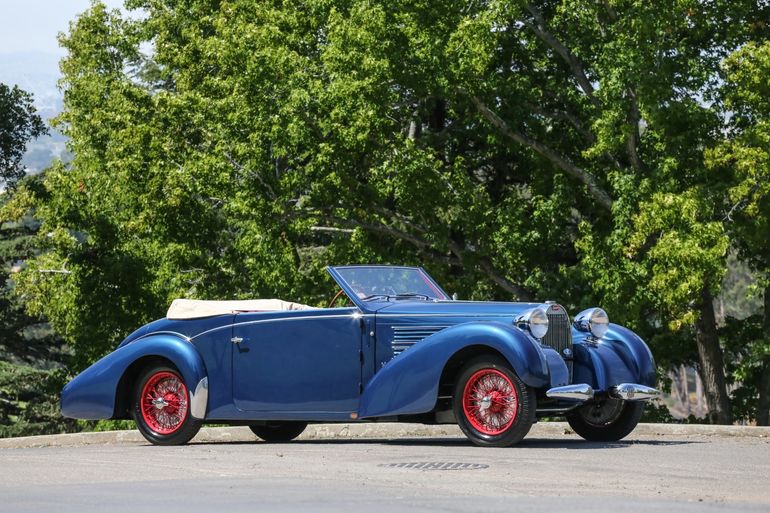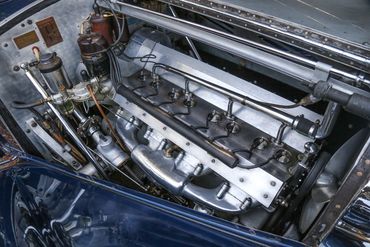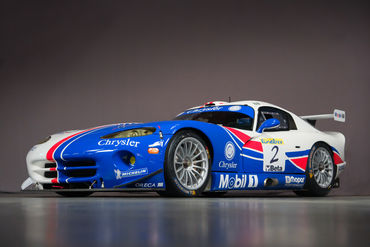Sold
SOLD 02/21
1939 Bugatti
Type 57 Stelvio by Gangloff
Beautifully Presented, Matching Numbers Example Accompanied by Over 60 Years of Fascinating Documentation. Incredibly Well Sorted, Ready for Long Distance Tours and Rallies.
- VIN57741
- Exterior ColorBlue
- Interior ColorRed
- Mileage20204 Miles (TMU)
- Engine3.3 Liter DOHC Straight 8-Cylinder
- Engine no.529
- Transmission4-Speed Manual
- StatusSold
- StockFJ2364
Description
1939 Bugatti Type 57 Stelvio
Coachwork by Carrosserie Gangloff
s/n 57741, engine no. 529
Blue with Red Leather Interior
Driven by passion, winning year after year top racing venues, and developed to be the finest in design and premier engineering, Ettore and Jean Bugatti built some of the most exquisite performance automobiles of any era. Bugatti customers were both particular and wealthy, often European royalty, famous artists, or motorsports enthusiasts. The product of Italian heritage and French Haute Couture, the brilliantly engineered Bugatti was clothed in sumptuous exclusive coachwork employing Avant Garde aesthetics and handmade details, blended with extraordinary mechanical excellence and aesthetic finery befitting the art deco era.
Introduced in 1934 and spanning into 1940, the Type 57 was not only a remarkable road car, it exceeded the high expectations of the rapidly growing automobile industry, particularly among elite clientele eager to own the very best. The new twin-overhead camshaft 3.3 liter inline eight-cylinder engine delivered a smooth and responsive 135hp through a four-speed manual transmission. Suspension was managed with live front axle and semi-elliptical leaf springs with live rear axle and inverted quarter-elliptical leaf springs. By 1938 15” hydraulic drum brakes were fitted with Rudge Witworth wire wheels, finishing off the sporting looks of the 130” wheelbase chassis.
Much of the Type 57 featured advanced design and engineering attributed to the brilliance of young Jean Bugatti, who personally championed the car beyond what “Le Patron” himself had envisioned. The excellence and craftsmanship delivered in the Type 57 greatly secured the Bugatti name as one of the premier luxury brands, well beyond their dominance in racing.
Among the many body styles offered for the Type 57, the most sought after was the Stelvio cabriolet. Named for the Passo dello Stelvio pass in the Eastern Alps (itself offering a history of great racing and superlative driving) this elegant open four-seater was bodied by a range of coachbuilders including the firm Carrosserie Gangloff. Founded in 1903 by Georges Gangloff, the Swiss/French coachbuilders established themselves as a premier constructor for nearly all of the top automotive luxury marques. As Bugatti customers often had specific requests, Stelvio body designs would range in detail and trim, making each car essentially one of a kind. Gangloff, having an establishment in Molsheim, near to Bugatti, were often chosen as the preferred coachbuilder for the Stelvio. The legacy of art and engineering in the Bugatti/Gangloff partnership can be seen in the refined execution of these beautifully constructed cars. The rarity and desirability of the Type 57 is further coupled by the fact that it was the last of the Bugatti family expression, with both Ettore and Jean Bugatti having been personally involved with the development of the car, prior to their passing.
This particular Bugatti is a superbly restored matching numbers Type 57 Stelvio with Gangloff coachwork, resplendent in beautiful blue and red colors. A late production example delivered to the factory in April 1939, this Bugatti has been professionally restored to a very high standard with documentation supporting nearly 60 years of ownership and care by Bugatti experts and collectors, validated by two long-term California collectors spanning more than fifty years. In addition to the matching numbers engine, it appears that the original body panels and most of the mechanical components still remain original to the car. Copies of service records accompanying the car include invoices from as early as 1961 including services by the firm O.A. Phillips, known to many Bugatti experts as Overton Axton “Bunny” Phillips, one of the most respected and foremost authorities on the Bugatti marque. Phillips was the first president and a co-founder of the American Bugatti Club, established in Southern California in 1960. The now famous Bugatti club printed their legendary club newsletter “Pur Sang” as one of the first authoritative documents on Bugatti automobiles, including rare histories and ownership references for many cars.
The Phillips service business was established by Bunny Phillips and Bob Estes in 1951 specifically to repair and sell Bugatti cars. In the Summer 1966 Pur Sang Vol. 7, Issue 2, page 11, #57741 is listed as “T57 Gangloff chassis 57741 with moteur 57741, ran at purchase with new set of spark plugs by Bunny Philips, now being slowly restored”. Having been serviced by Mr. Phillips personally multiple times throughout the 60s and 70s, the owner of this Stelvio, Mr. Ted Rose, Hidden Hills, CA, engaged Phillips for an ongoing range of service and cosmetic work on the car, sometimes spending thousands of dollars at a time when a new American car could be purchased for the same price. Mr. Rose retained the car until he sold it to George Rowland, Jr. on April 28, 1983. Rowland engaged several top-level restoration experts to work on the car throughout the 1990s and into the 2000s. Restoration invoices from one expert exceeded $90,000.00 while another through 2000-2018 exceeded $26,000.00. Bugatti experts at Competition Motors, Ltd. performed much of the mechanical work on the car in order to prepare it to the level of excellence still evident in the condition today. Examining more than 300 pages of detailed service and restoration documentation included with the car reveals the fastidious notations reflecting both the repair processes and methods used restoring the car to correct mechanical standards and highly refined cosmetic presentation.
Today this magnificent Type 57 Stelvio exhibits impressive presence and elegant coachwork, despite some time having lapsed since the high-quality restoration was completed. The exquisite design of the original coachbuilt body combined with the restoration reflect the past handcrafting combined with the present artfulness of an authentically restored Bugatti. The gorgeous vibrant blue paint captures the fluid Galgloff Stelvio design perfectly. The flowing fenders are elegantly positioned to the body, absent of running boards or any excessive trim. The finish is wonderfully applied with excellent gloss, superb body contours, and liquid reflections. The fender lines are contrasted by Rudge wire wheels, which have been painted red to accent the matching interior. Minor evidence of use and mild settling to the restoration is evident, including a few small paint imperfections, but none of significance to detract from the otherwise handsome presentation. Chrome trim, lighting, and various other polished elements glisten as wonderful bits of exterior jewelry, all of which have been correctly restored using proper lenses and housings, enhancing the body design without detracting from the beauty of the elegant coachwork. A handsome touch to the body is the covered spare tire nestled in the passenger side front fender. Like much of this coachwork, this detail hints at the full envelope body shapes of the future with blended fenders, recessed grille, covered mechanical features, and the absence of a rear bumper or excessive trim. The delicately finished rear of the car also conceals innovation as a fully shaped trunk lid conceals the panel break beneath the sculpted beltline accent.
The interior is colorful and engaging, finished with vivid red leather upholstery, with tasteful door panel stitching, and properly piped and contoured seats. The driver’s seat has a slight bit of relaxed contour to the seat bottom, minor evidence of use in the foot box area of the carpeting, and some scuff marks on the aluminum entrance thresholds, but otherwise, all materials are very clean, nicely presented, and correctly displayed. The interior is not only refined and beautifully composed, it contains a spacious amount of seating room for rear passengers; a welcome addition for events including more than one guest. The black gauges combined with the sculpted chrome handles and various levers deliver the perfect combination of luxury and sporting flair. The tan canvas top raises and lowers easily and is taut when erected in position. Fitting and condition of the top boot is also very handsome, elegantly concealing the folded top when lowered in place. The trunk is very nicely upholstered with handsome matching red carpets and perimeter binding in harmony with the interior.
Lifting the centrally hinged hood, each side of the magnificent matching numbers 3.3 liter rubber mounted Bugatti engine is a delight of engine turning, castings, and combined fabrication brilliance. The original engine, boasting decades of expert preservation, now has a beautiful mellowed presence enhanced by natural finishes and delightful mechanical details. Light satin aluminum reflects against the copper elements, raw cast parts, and polished aluminum pieces, all of which come together equalized by time, settling mildly to the restored engine. The exhaust side of the engine delivers a clean dark grey cast manifold which contrasts the more complex and polished intake side. Other details include correct Bosch and Scintilla components, proper fabric woven lacquered electrical wiring, and engine turning on the engine and firewall. Handsomely restored, the engine exhibits a respectful patina of lightly toned components conveying the integrity of a monumental car, allowed to gracefully mature with reverence for enjoyable use. The underside of the car reveals a nice combination of materials and finishes reflective of the restoration, however, some areas are now showing evidence of use and surface patina. There is no visual evidence of structural damage to the car or mechanical components.
The car starts easily, delivering warm, mechanical sounds echoing a history of race-bred performance. The twin cam engine is spirited and eager, thus impressive when pulling away. A notably classic 1930s era ride is revealed at cruising speeds. Under higher speeds, the comfort and composure are quite good with the top down, though ladies may prefer to don a bonnet. For those unfamiliar with prewar cars, braking and gear selection requires some planning but once understood, the hydraulic brakes are a welcome addition to the more challenging mechanical brakes of the earlier series cars. Included with the car are hundreds of pages of documentation contained in a notebook, extensively chronicling the maintenance and restoration from the two dedicated long-term owners.
Beautifully composed and elegantly draped in Gangloff coachwork this Bugatti Type 57 Stelvio represents the finest in Bugatti motorcars. The refined chassis and four passenger open configuration are an excellent pairing to deliver all the exhilaration and elegance of driving in one of the most exquisite automobile marques of the twentieth century. Handsomely restored with a documented history of superlative service, restoration, and care spanning more than half a century, this phenomenal expression of Bugatti’s finest is ready for any prestigious concours or touring event, while continuing to maintain the preservation and ownership joy associated with one of the finest examples of automotive artistry ever constructed.
The above vehicle information is complete and accurate to the best of our knowledge at the time it is posted to this website. Corrections or additional information is always appreciated. All advertised prices exclude government fees and taxes, any finance charges, any dealer document preparation charge, and any emission testing charge. Vehicles are subject to prior sale. All advertised to be true but not guaranteed. We assume no liability for errors or omissions.
Inquire About This Car
Fantasy Junction • 510-653-7555 • 1145 Park Ave, Emeryville, CA 94608





